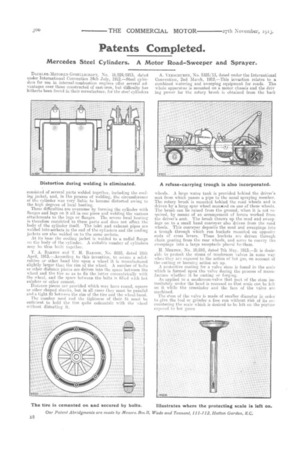Patents Completed.
Page 24

If you've noticed an error in this article please click here to report it so we can fix it.
Mercedes Steel Cylinders. A Motor Road-Sweeper and Sprayer.
DAIMLER-MOTORENESELLSCIIAFT, No. 16,924/1913, dated under International Convention 24th July, 1912—Steel cylinders for use in internal-combustion engines offer several advantages over those constructed of cast-iron, but difficulty has hitherto been found in their manufacture, for the steel cylinders
consisted of several parts welded together, including the cooling jacket, and, in the process of welding, the circumference of the cylinder was very liable to become distorted owing to the high degrees of local heating.
These difficulties are overcome by forming the cylinder with flanges and lugs on it all in one piece and welding the various attachments to the lugs or flanges. The severe local heating is therefore restricted to these parts and does not affect the body of the cylinder itself. The inlet and exhaust pipes are welded into sockets in the end of the cylinders and the cooling jackets are also welded on to the same sockets.
At its base the cooling jacket is welded to a radial flange on the body of the cylinder. A suitable number of cylinders may be thus bniit together.
T. A. BARTON and T. H. BARTON, No. 8895, dated 16th April, 1913.—According to this invention, to secure a solidrubber or other band tire upon a wheel it is manufactured slightly larger than the rim of the wheel. A number of bolts or other distance pieces are driven into the, space between the wheel and the tire so as to fix the latter concentrically with the wheel, and the. space between the bolts is filled with hot sulphur or other cement.
Distance pieces are provided which may have round, square or other shaped shanks, but in all cases they must be pasallel and a tight fit between the rim of the tire and the wheel.band.
The number used and the tightness of their fit must. be sufficient to hold the tire quite coficentria with the wheel without distorting it, A. V ERSCHUREN, No. 5325/13, dated under the International Convention, 2nd March, 1912--This invention relates to a combined watering and sweeping equipment for roads. The whole apparatus is mounted on a motor chassis and the driv ing power for the rotary brush is obtained from the back
wheels. A large water tank ia provided behind the driver's seat from which passes a Pipe to the usual spraying member. The rotary brush is mounted behind the road wheels and is driven by a large spur wheel moused on one of these wheels. The brush can lie raised from the ground, when it is not required, by means of an arrangement of levers worked from the driver's seat. The brush throws up the mud and sweepings on to a small band conveyer also driven from the road wheels. This conveyer deposits the mud and sweepings into a trough through which run buckets mounted on opposite ends of cross levers. These buckets are driven through chain gearing from the rear wheels, and serve to convey the sweepings into a large receptacle placed for them.
II. MERTON, No. 10,810, dated 7th May, 1913.—It is desirable to protect the stems of mushroom valves in some way when they are exposed to the action of hot gas, on account of the cutting or burning action set up.
A protective coating for a valve stem is found in the scale which is formed upon the valve during the process of manufacture whether it be casting or forging.
As applied to a mushroom-valve that part of the stem immediately under the head is recessed so that scale can be left on it while the remainder and the face of the valve are machined.
The stem of the valve is made of smaller diameter in order to give the tool or grinder a free run without. risk of its encountering the scale which is desired to be left on the portion exposed to hot gases
























